Headline
Traditional PUJs resume ops in some areas

Presidential Spokesperson Harry Roque said traditional jeepneys are already operating in some areas with low-risk Covid-19 infection such as Baguio and Bohol. (File photo: Yannes Kiefer/Unsplash)
MANILA – Traditional public utility jeepneys (PUJs) have resumed operations in some provinces and regions where public utility buses (PUBs) and other public utility vehicles (PUVs) are not enough to service commuters, Malacañang said on Monday.
Presidential Spokesperson Harry Roque said traditional jeepneys are already operating in some areas with low-risk Covid-19 infection such as Baguio and Bohol.
“Maraming lugar na walang bus at walang modern PUV kaya sa mga lugar na iyan ay pinapayagan po ang traditional jeepneys. Sa Baguio, sa Bohol, ilan lang po ito na may traditional jeepneys na (There are many areas without buses and modern PUVs where traditional jeepneys are permitted. Baguio and Bohol are some areas where traditional jeepneys have resumed operations),” he said in a virtual presser.
He said jeepneys are also operating in Bulacan, Pampanga, Cagayan de Oro, South Cotabato, and Siguijor.
Jeepneys are also serving commuters in Ilocos, Western Visayas, Eastern Visayas, Central Visayas, Northern Mindanao, Davao Region, Caraga Region, Cordillera Administrative Region (CAR).
However, jeepneys are still prohibited from plying the streets of Metro Manila.
The LTFRB earlier said only “road-worthy” jeepneys will be allowed to resume operations.
“If you are referring to Metro Manila, let’s wait for LTFRB to make the decision,” Roque said.
Meanwhile, Roque announced that 980 UV Express vans plying between Metro Manila and nearby provinces will initially be allowed to operate in 47 routes starting Monday.
Operators and drivers of UV Express are advised to strictly comply with the guidelines that their routes shall be terminal-to-terminal, no pick up and drop off of passengers, and must not pass through nor traverse Edsa and Commonwealth Avenue, except to cross, he said.
He also said the existing UV Express fare rate of PHP2 per kilometer remains, and that no fare adjustment shall be applied unless approved by the LTFRB.
LTFRB chair Martin Delgra said the LTFRB is following a “hierarchy”, wherein transport modes with higher passenger capacity will be prioritized such as trains, buses, and modern public utility vehicles (PUVs) as long as minimum health standards are observed.





















